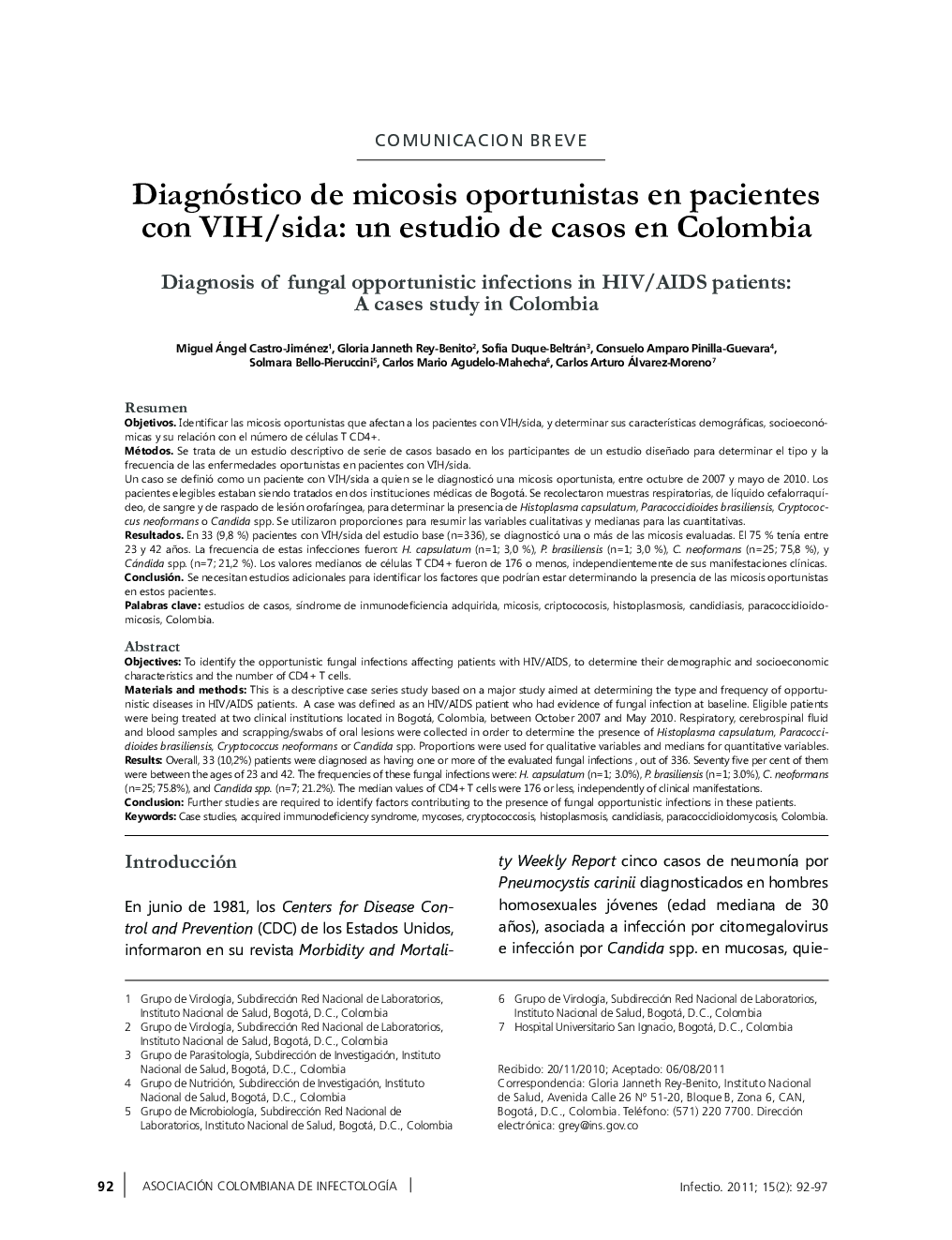| کد مقاله | کد نشریه | سال انتشار | مقاله انگلیسی | نسخه تمام متن |
|---|---|---|---|---|
| 3403821 | 1223096 | 2011 | 6 صفحه PDF | دانلود رایگان |

ResumenObjetivosIdentificar las micosis oportunistas que afectan a los pacientes con VIH/sida, y determinar sus características demográficas, socioeconómicas y su relación con el número de células T CD4+.MétodosSe trata de un estudio descriptivo de serie de casos basado en los participantes de un estudio diseñado para determinar el tipo y la frecuencia de las enfermedades oportunistas en pacientes con VIH/sida.Un caso se definió como un paciente con VIH/sida a quien se le diagnosticó una micosis oportunista, entre octubre de 2007 y mayo de 2010. Los pacientes elegibles estaban siendo tratados en dos instituciones médicas de Bogotá. Se recolectaron muestras respiratorias, de líquido cefalorraquídeo, de sangre y de raspado de lesión orofaríngea, para determinar la presencia de Histoplasma capsulatum, Paracoccidioides brasiliensis, Cryptococcus neoformans o Candida spp. Se utilizaron proporciones para resumir las variables cualitativas y medianas para las cuantitativas.ResultadosEn 33 (9,8 %) pacientes con VIH/sida del estudio base (n = 336), se diagnosticó una o más de las micosis evaluadas. El 75 % tenía entre 23 y 42 años. La frecuencia de estas infecciones fueron: H. capsulatum (n = 1; 3,0 %), P. brasiliensis (n = 1; 3,0 %), C. neoformans (n = 25; 75,8 %), y Cándida spp. (n = 7; 21,2 %). Los valores medianos de células T CD4+ fueron de 176 o menos, independientemente de sus manifestaciones clínicas.ConclusiónSe necesitan estudios adicionales para identificar los factores que podrían estar determinando la presencia de las micosis oportunistas en estos pacientes.
ObjectivesTo identify the opportunistic fungal infections affecting patients with HIV/AIDS, to determine their demographic and socioeconomic characteristics and the number of CD4+ T cells.Materials and methodsThis is a descriptive case series study based on a major study aimed at determining the type and frequency of opportunistic diseases in HIV/AIDS patients. A case was defined as an HIV/AIDS patient who had evidence of fungal infection at baseline. Eligible patients were being treated at two clinical institutions located in Bogotá, Colombia, between October 2007 and May 2010. Respiratory, cerebrospinal fluid and blood samples and scrapping/swabs of oral lesions were collected in order to determine the presence of Histoplasma capsulatum, Paracoccidioides brasiliensis, Cryptococcus neoformans or Candida spp. Proportions were used for qualitative variables and medians for quantitative variables.ResultsOverall, 33 (10,2%) patients were diagnosed as having one or more of the evaluated fungal infections, out of 336. Seventy five per cent of them were between the ages of 23 and 42. The frequencies of these fungal infections were: H. capsulatum (n = 1; 3.0%), P. brasiliensis (n = 1; 3.0%), C. neoformans (n = 25; 75.8%), and Candida spp. (n = 7; 21.2%). The median values of CD4+ T cells were 176 or less, independently of clinical manifestations.ConclusionFurther studies are required to identify factors contributing to the presence of fungal opportunistic infections in these patients.
Journal: Infectio - Volume 15, Issue 2, June 2011, Pages 92-97